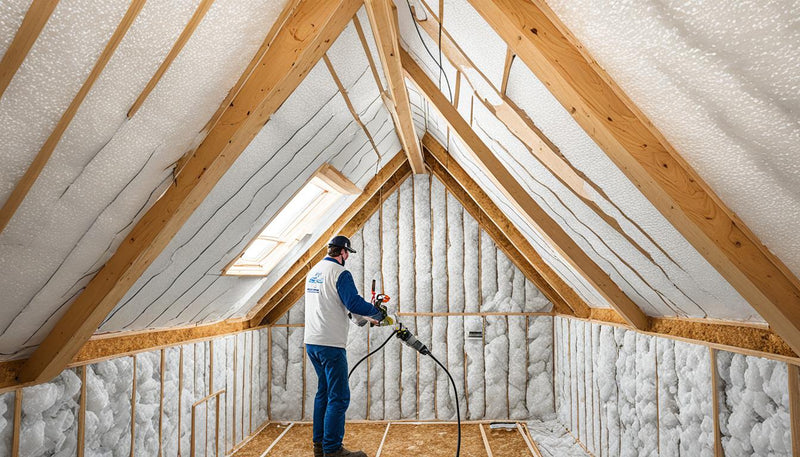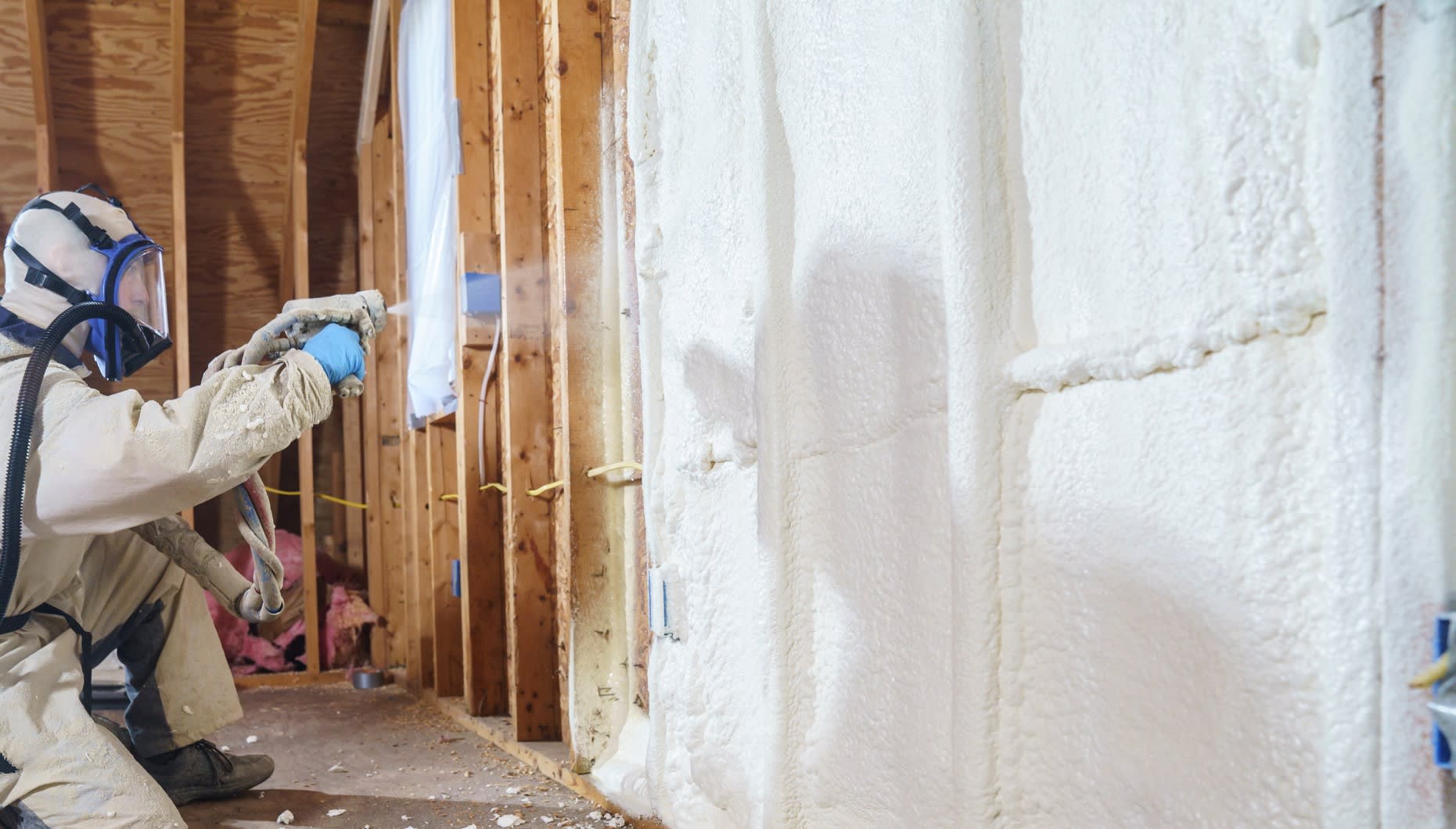Spray Foam: The Ultimate Option for Air Sealing and Insulation
Spray foam insulation has actually become a leading option for reliable air sealing and thermal insulation, providing an one-of-a-kind combination of residential properties that establish it apart from conventional approaches. Its capacity to expand and fill spaces makes it especially reliable in protecting against air leakage, which can considerably affect power effectiveness. Recognizing the complete extent of its benefits, setup procedures, and contrasts with other insulation kinds is crucial for making notified choices. As we discover these aspects, the ramifications for both brand-new building and constructions and retrofits come to be significantly substantial. What aspects should affect your option?
What Is Spray Foam?
Spray foam is a versatile insulation product that integrates the principles of air securing and thermal resistance to improve energy performance in structures. Composed largely of polyurethane or other similar substances, spray foam is used as a liquid that increases upon contact with surfaces, producing a solid, continual layer of insulation. This special residential property enables it to load spaces, cracks, and gaps that conventional insulation products may overlook, supplying an exceptional air seal.
There are 2 primary kinds of spray foam: open-cell and closed-cell. Open-cell spray foam is lighter and a lot more flexible, using excellent audio absorption and a lower R-value per inch - Spray Foam. In comparison, closed-cell spray foam is denser, providing a higher R-value, dampness resistance, and added architectural integrity to constructing components
The application procedure typically includes specialized devices, making certain a seamless application that abides by various substrates, consisting of timber, metal, and concrete. This adaptability makes spray foam appropriate for both brand-new buildings and retrofitting existing structures. Its capability to create an airtight obstacle dramatically contributes to minimizing power intake and improving indoor air high quality, therefore making it a preferred option amongst house owners and building contractors alike.
Advantages of Spray Foam Insulation
One of the most significant advantages of spray foam insulation is its outstanding capacity to create a continuous air barrier, which effectively reduces energy loss. Unlike conventional insulation materials, spray foam broadens to fill up spaces and fractures, making sure that air leak is substantially lowered. This particular not just boosts power effectiveness however likewise results in lower energy costs with time.
In addition, spray foam insulation supplies remarkable thermal resistance, adding to a much more stable indoor setting. Its high R-value per inch enables efficient insulation in restricted areas, making it excellent for attic rooms, walls, and crawl areas. The moisture-resistant buildings of spray foam assistance avoid mold and mildew and mold growth, advertising much healthier living conditions.
An additional important benefit of spray foam insulation is its sound-dampening qualities (Spray Foam). It successfully decreases sound transmission between areas, producing a quieter and more comfy home environment. The durability of spray foam likewise stands apart, as it does not droop or work out with time, preserving its efficiency throughout its lifespan
Just How Spray Foam Works
Recognizing how spray foam insulation functions is essential for valuing its effectiveness in air sealing and thermal resistance. Spray foam insulation is composed of two main components: isocyanate and polyol resin. When these parts are mixed, they go through a chain reaction that triggers the product to broaden swiftly, creating a dense foam that loads cracks, spaces, and dental caries.
As the foam expands, it complies with surface areas, creating an airtight seal that considerably minimizes air seepage. This particular makes spray foam insulation highly effective at stopping drafts and dampness infiltration, which can lead to energy loss and damage in time. Furthermore, the closed-cell variation of spray foam supplies premium thermal resistance due to its rigid structure, effectively reducing warm transfer.
The special buildings of spray foam permit it to satisfy uneven surface areas, making certain thorough insurance coverage and a smooth obstacle. Consequently, spray foam insulation not just improves energy efficiency but also adds to boosted indoor air quality by decreasing the accumulation of toxins and irritants. Eventually, comprehending the mechanics behind spray foam underscores its duty as a premium option for insulation and air sealing in both business and property applications.
Installment Process Overview

Before installment, the space should be appropriately cleaned up this content and prepped, making sure that surface areas are devoid of moisture, dust, and debris. Because contaminants can jeopardize bond and general efficiency, this action is critical. Once the area is prepared, the application involves mixing both elements of the spray foam, which broadens upon get in touch with and fills up spaces properly.
Educated specialists need to perform the installment, making use of specialized equipment to ensure uniform coverage and optimum thickness. Safety and security preventative measures, consisting of putting on safety equipment and making sure appropriate ventilation, are crucial throughout this process. After application, the foam usually remedies rapidly, forming a strong obstacle that improves energy efficiency.
Comparing Spray Foam to Typical Insulation
When assessing insulation alternatives, spray foam insulation stands out in comparison to traditional products such as fiberglass and cellulose. Unlike fiberglass and cellulose, which can allow air seepage, spray foam broadens upon application, loading spaces and crevices to develop an airtight seal.
In addition, spray foam offers a greater R-value per inch than conventional insulation kinds, providing even more effective thermal resistance in a thinner account. This characteristic is specifically advantageous in rooms with restricted dental caries depth. In addition, spray foam is resistant to wetness and mold and mildew growth, which can be a substantial interest in cellulose and fiberglass, specifically in humid atmospheres.
Nonetheless, spray foam insulation generally brings a greater upfront cost than its standard equivalents. Homeowners need to consider this first investment against long-lasting power financial savings and performance benefits. Eventually, while both insulation kinds offer their objective, spray foam arises as an advanced service for contemporary insulation demands, specifically in regards to air securing and thermal efficiency.

Conclusion
In summary, spray foam insulation represents a very reliable remedy for attaining optimum air securing and thermal resistance. Its one-of-a-kind properties, consisting of dampness resistance and audio dampening, make it ideal for different applications in both new buildings and retrofitting projects (Spray Foam). Although the initial costs might be greater compared to conventional insulation materials, the lasting advantages, such as considerable energy savings and boosted interior air high quality, justify the financial investment and emphasize its value in modern structure methods.
Spray foam insulation has arised as a leading option for effective air securing and thermal insulation, providing an unique combination of residential or commercial properties Homepage that establish it apart from standard methods.Spray foam is a functional insulation material that incorporates the principles of air securing and thermal resistance to enhance power efficiency in structures.When assessing insulation alternatives, spray foam insulation stands out in comparison to typical materials such as fiberglass and cellulose. Inevitably, website here while both insulation types offer their purpose, spray foam emerges as an extra sophisticated remedy for contemporary insulation demands, particularly in terms of air securing and thermal performance.
In summary, spray foam insulation stands for a very efficient remedy for achieving ideal air securing and thermal resistance.